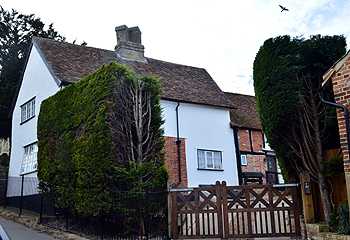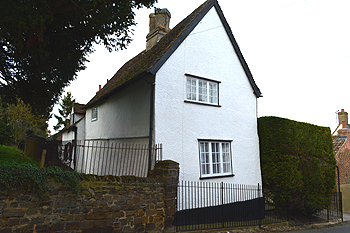The White Horse Public House Shillington

52 Church Street March 2014
The White Horse Public House: 52 Church Street, Shillington
The White Horse was one of Shillington's older pubs dating from the 18th century, though the property itself is older. It was listed by the former Department of Environment inJuly 1975 as Grade II, "of special interest". It dates from the 17th century, with 18th century additions, the latter, presumably when it became a public house. It is of timber-framed construction, though parts of the ground floor have been rebuilt in brick. It has had colourwashed roughcast render applied to most areas, but some timbering with red brick infill is exposed to the later block. It has clay tile roofs and comprises two storeys. It originally had a two room plan, standing gable end to road, with a later one storey and attics block added to rear gable.
Bedfordshire and Luton Archive and Record Service has some research carried out on the early history of the house, reading as follows [CRT130 Shillington 7]: "This house adjoining the churchyard at Shillington may once have been the church store house. The present owner thinks there is a tunnel which leads from his cellar to the crypt of the church but he hasn't got beyond the brick archway upon which he bases his theory. If it was a store house for the church, there are notes in the Shillington churchwardens' accounts that it was made clean in 1595 and 1575, that stones were carried into it in 1586 (for which a payment was made to John Caynhose) that the storehouse window was mended in 1581 and that the key and lock for the door were repaired in 1601" [P44/5/1].
On 7th July 1813 a manor court presented the admission of Edward Ind to a messuage in Church End "now and for many years past used as a public victualling house called the White Horse in occupation of Lewis Flint as 2nd May 1798 with a piece of land adjoining of 2 roods, 16 poles" [CRT130Shillington6]. The property was copyhold and held from the Manor of Shillington Rectory. John Izard Pryor was admitted tenant on 19th June 1816 and on 8th April 1854 surrendered the property for £295 to Joseph and Thomas George Simpson both late of Long Stow Hall [Cambridgeshire] now of Baldock [Hertfordshire]. They were brewers. The property was enfranchised, that is, converted into freehold, on payment of a fine of £62/5/10 to the Lord of the Manor, early in the 20th century.
The public house closed in December 1914 and sold by Evelyn Shaw-Hellier (née Simpson) to Alfred Prutton of Shillington, innkeeper on 4th January 1915 [CRT130Shillington6]. The Rating and Valuation Act 1925 specified that every building and piece of land in the country was to be assessed to determine its rateable value. The valuer visiting 52 Church Street [DV1/C75/18] found that it comprised two living rooms, a kitchen, a scullery and four bedrooms (one in the roof). Outside were a washhouse, three piggeries, two further piggeries and two loose boxes. The valuer noted: "was pub, all over the place". There was an adjoining orchard.
Alfred Prutton's will of 1931 gave his property to his wife and he died in May 1934. Susan Prutton's will of 1939, proved in October 1947, devised the property to her executors - daughter and son-in-law Harriet and Fred Charles Dawes. They sold 52 Church Street to Kathleen Granger for £600 in 1947. She died 1963 and property passed to Noel John Granger who was living there [CRT130Shillington6].

52 Church Street gable end March 2014
Sources:
- CRT110/102: Baldock Brewery deeds: 1740-1898;
- HE233: auction sale held at White Horse: 1814;
- CLP13: countywide licensing registers: 1822-1828;
- QSR1838/1/5/5: shawl stolen from a customer: 1838;
- QSR1849/4/5/17/a: stolen goods offered for sale at White Horse: 1849;
- PSA5/1: Register of Alehouse Licences - Ampthill Petty Sessional Division: 1872-1927;
- CR/OH1/5: recollections of the public house c. 1920-1939: 199
Licensees: Note that this is not a complete list; italics indicate licensees whose beginning and/or end dates are not known
1798-1828: Lewis Flint;
1847-1854: Sarah Simkins;
1862-1869: William Simkins;
1876-1879: Mary Simkins;
1879-1885: Frederick Smith;
1885-1914: Alfred Prutton
Public house closed: 26th December 1914